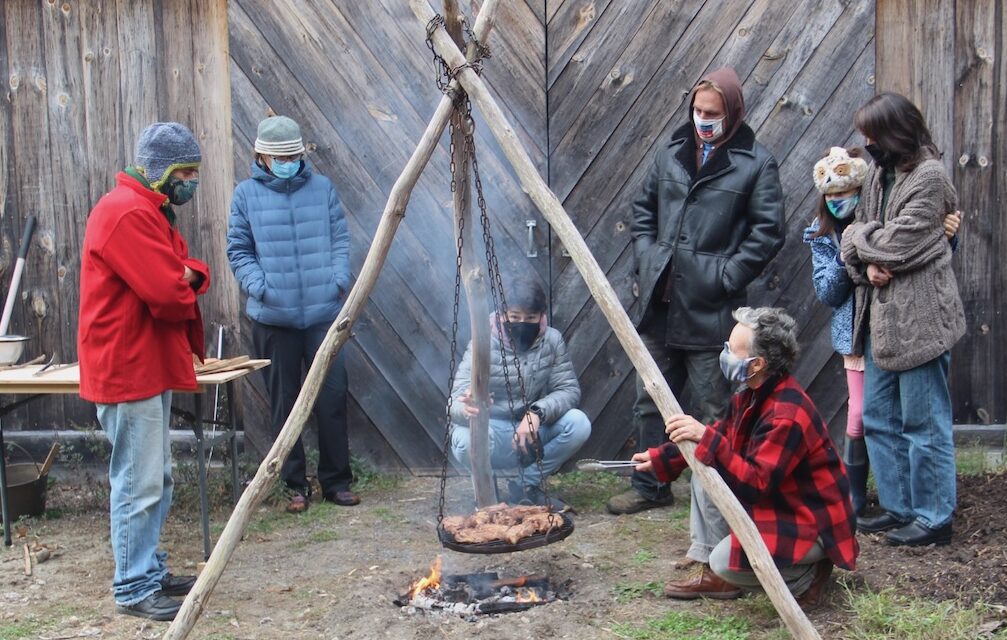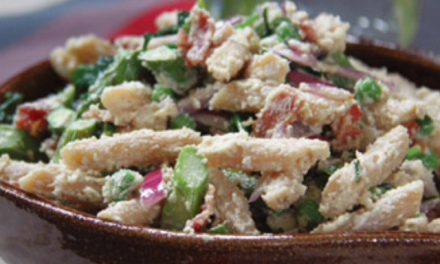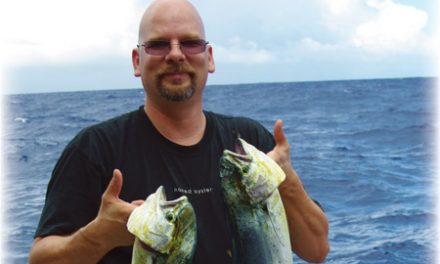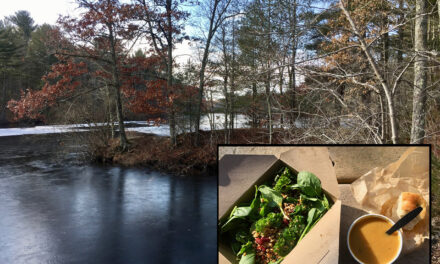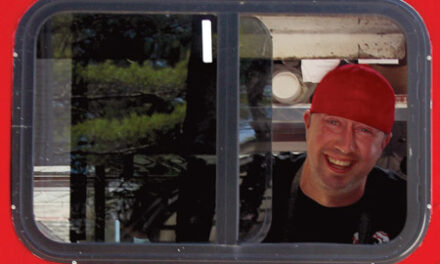By Paula Marcoux • Photo by Mike Race.
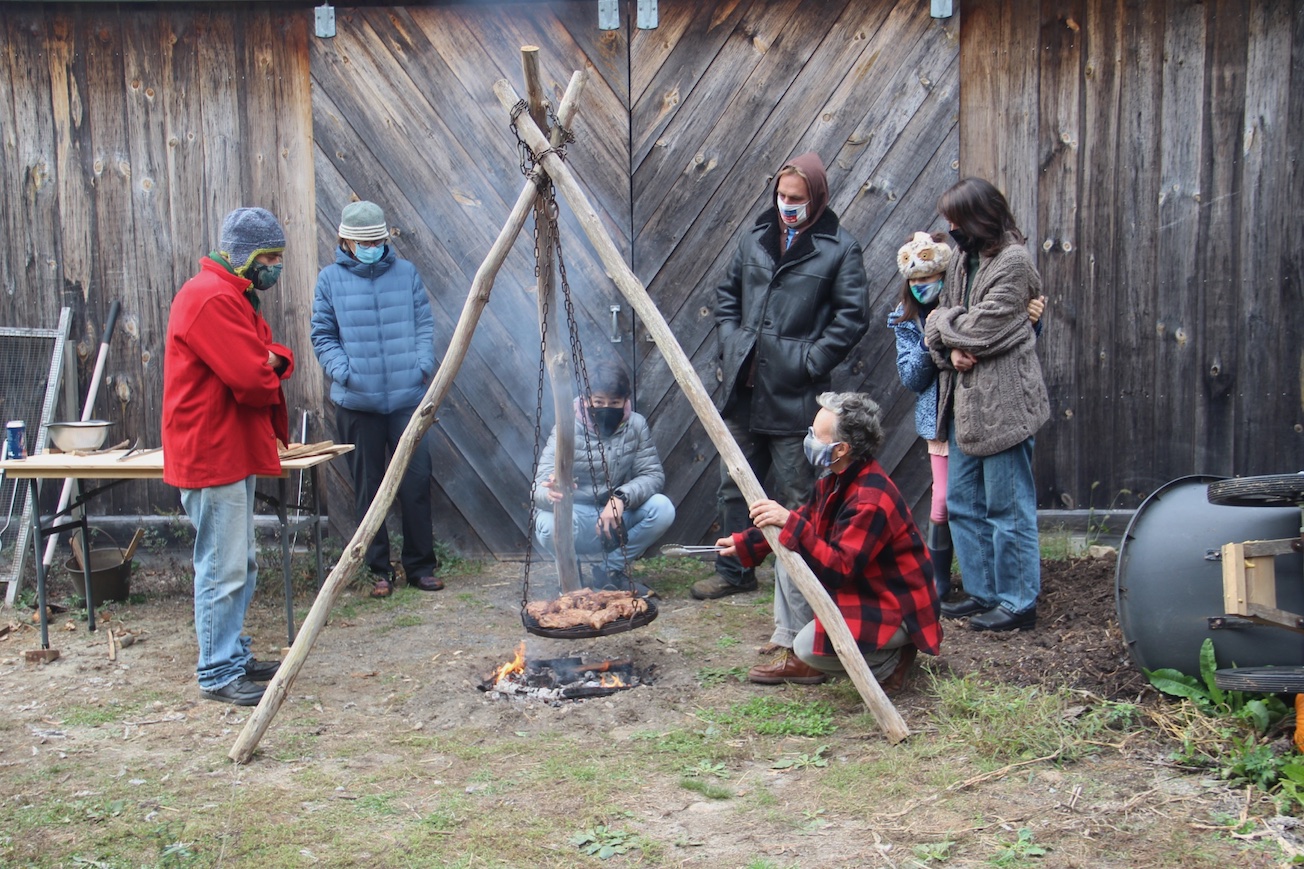
The perpetual motion of the schwenker makes grilling country-style pork ribs to perfection over a hardwood fire easy and fun.
Fire, Food, Friends…Outdoors
All beautiful summer and fall of this Covid-bound year, we repeated our gratitude for being able to entertain ourselves and a few others, if distantly, outdoors—at the beach, on the patio, in the woods. The flip-side of the oft-heard refrain, “At least we have this—we’re lucky to live in such a gorgeous place,” was the tacit apprehension at the thought of retreating to winter bunkers when days would grow short and cold. And while the reality of that dread cannot be denied, experts agree that certain strategies may help make life feel joyful even as we do our battened-down best to slow the spread.
I’ll leave it to psychologists and other professionals to give advice on general coping during the pandemic; all of my pointers boil down to a few notions:
Cook something delicious for a friend or two, preferably over fire, outdoors. Extra points for delving into a family tradition, a challenging cooking style, or a historic idea. Using local ingredients a distinct plus, of course.
Winter fires have long been a celebratory motif for us. On occasion, we have kept watch under a starry sky an entire long frosty night. And of course, every fire calls out to cook something.
A few helpful hints for bringing more outdoor cooking into your winter season:
Think through your cooking fire and prepare your gear ahead. This can be as simple as figuring out how you can set up a pot to simmer your grandma’s minestrone over embers. A few bricks and an old grill grate work wonders.
Plan to make a separate fire nearby to keep everyone warm. The best cooking fires are pretty poor at throwing the heat and light that outdoor socializing requires. Conversely, if you have a big fire going, the quickest route to a great cooking fire is to steal a shovelful of embers from under it to start a culinary subsidiary in a convenient nearby location. Proceed to build your new fire up with small bits of hardwood.
Maintain a stockpile of dry wood for entertaining. Sitting around a smoking, spitting smolder is no fun. You’ll want dry hardwood for cooking, but dry pine is perfectly fine for your atmospheric fire.
Remind guests to bundle up. We like to have a few extra coats, hats, and blankets on hand to keep everyone cozy when things get really frosty.
Try something new. Despite my just-lodged resistance to gadgets, every now and again we come across an idea for specialized gear that just might have enough merit to be evaluated in our household. We happened to hear of the schwenker, a swinging grill popular in the Saar region of northern Germany, at a time when one of us was learning to weld, making it a nearly inevitable addition to our outdoor cooking battery. Turns out to not be a mere gimmick, as the continual action provides exceedingly even cooking over hardwood—even for cuts of meat that can be a bit challenging on an open grill—but perfect for country style pork ribs.
More Schwenker Hints:
Keep the menu really simple. A pot of soup, a coil of sausage, some grilled shellfish with herb butter … any of these, along with a pile of crusty rolls, can stack up to interactive and protracted fun.
Use what you have. No need for fancy equipment beyond a pair of tongs, a cast iron skillet, and a soup pot you’re not too worried about.
…and Schwenker Tips:
Make sure that your grill grate is comparatively robust. If you repurpose a cheap light one, think about running a few reinforcing rods beneath, maybe to the attachment points for the suspension chains.
Want a bespoke model? If welding is not among your household skills, ask around and support your local economy! Child’s play for your neighborhood fabricator.
The taller the legs of your tripod, the longer your grill tends to circulate without help from you. Not that it’s that taxing to nudge it every few minutes.
Burn a nice little fire of hardwood for about 40 minutes before hanging the grill, then, once you’re cooking, feed the fire from the edges with small chunks or sticks of hardwood, keeping a sweet bed of coals going. A few flames under the food are not as troublesome as with a regular grill, because of the constantly moving cooking plane.
Grill too high? Move the tripod legs out. Too low? Move them together. Sometimes complex geometry can be our friend.
Paula Marcoux is a food historian isolating in her winter burrow in Plymouth and dreaming about gathering casually and indiscriminately with humans again. She is the author of Cooking with Fire.

